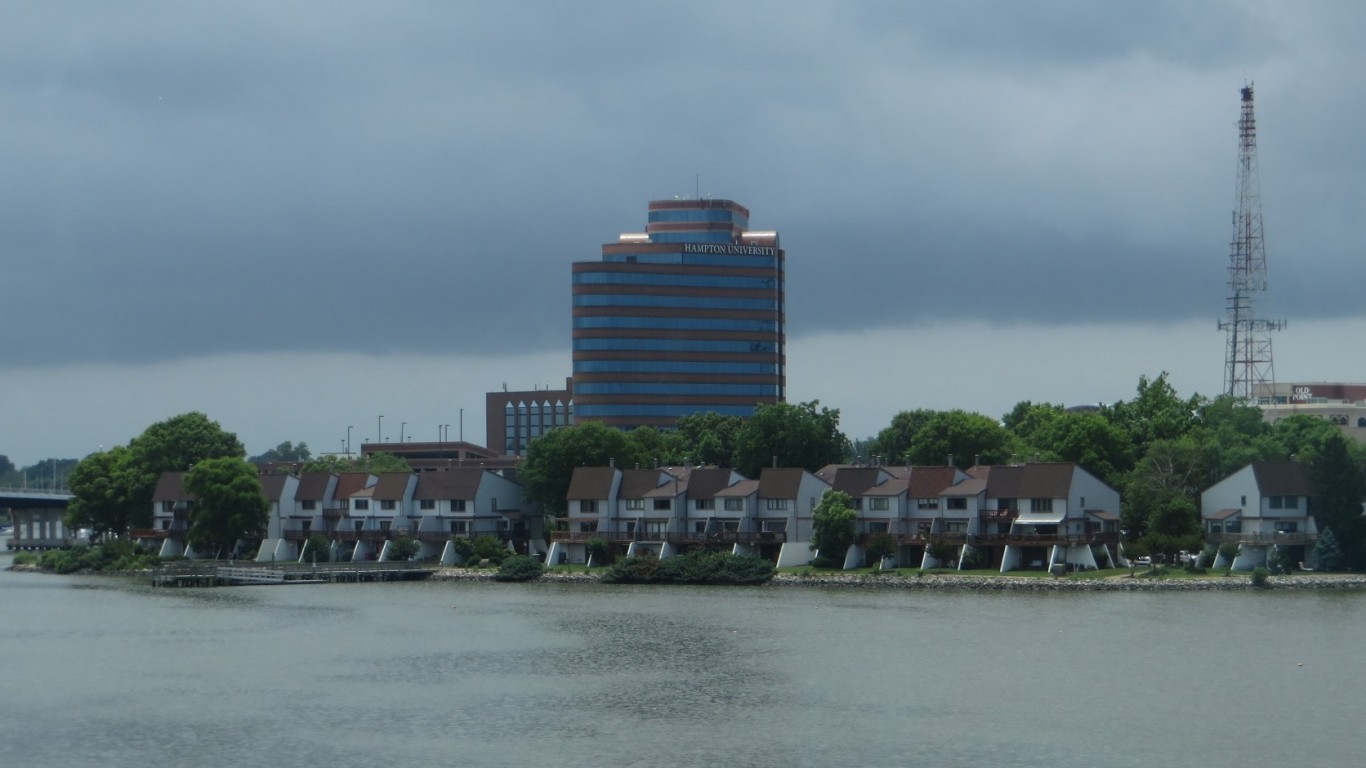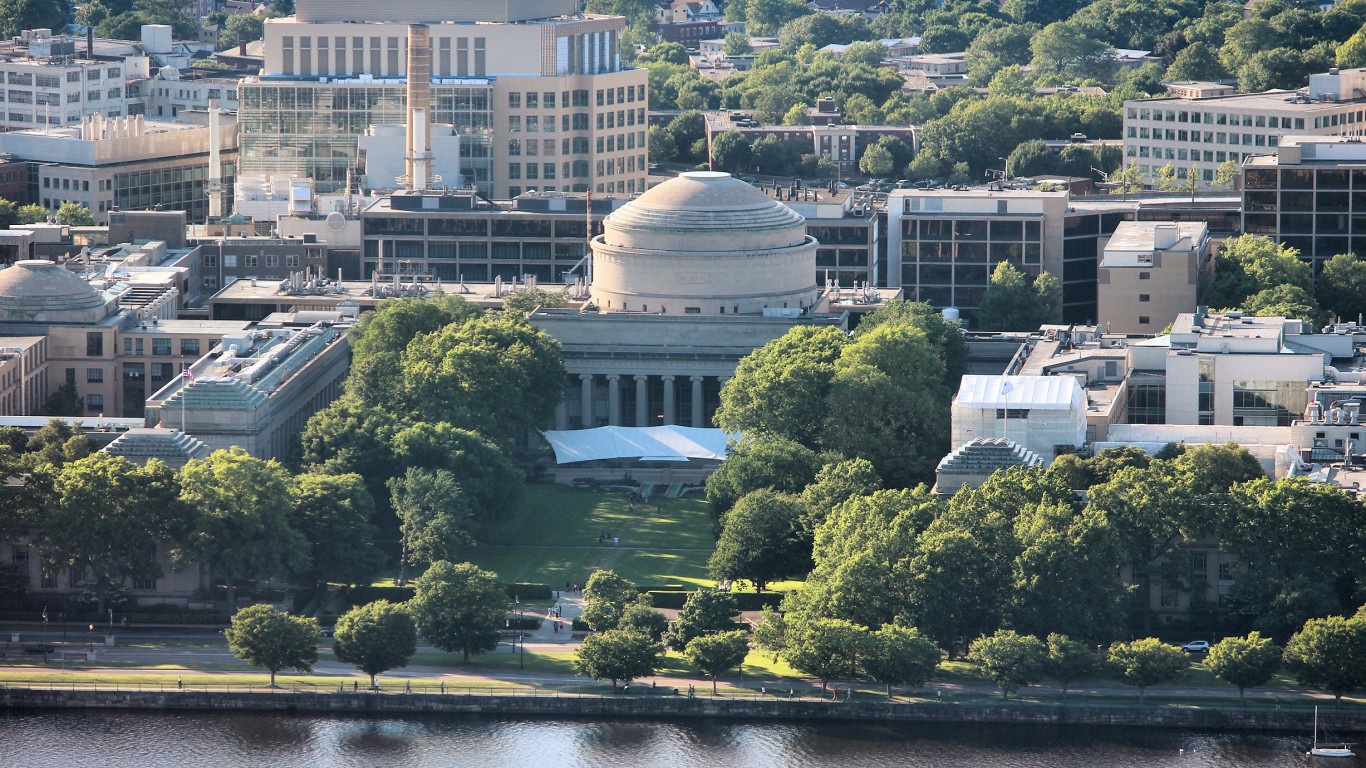
The United States is becoming an increasingly racially and ethnically diverse country. Today, about 60% of Americans identify as white. But, according to some projections, there will not be a single racial or ethnic majority in the country by 2055.
As the country becomes more diverse, other aspects of American society will become more diverse as well. For many businesses and organizations, both public and private, diversity is a growing priority. Perhaps nowhere is diversity more important, however, than in the institutions that are training the future generation — America’s colleges and universities.
In an interview with 24/7 Wall St., Elon University Professor of Communications Dr. Naeemah Clark explained the benefits of diversity on college campuses in the context of an increasingly diverse country. “When we bring in students from different geographical backgrounds, different economic classes, different races, different ethnicities, different faiths, we can approach real-world problems with more realistic solutions,” Clark said.
Still, there are many higher education institutions where the vast majority of students identify as a single race or ethnicity. 24/7 Wall St. reviewed data from the U.S. Department of Education to identify the colleges with the least diverse student bodies. Schools were ranked on the likelihood that two students chosen at random would be of a different race, ethnicity, or citizenship status. Across all undergraduates nationwide, such a likelihood is about 69.6%. Among the schools on this list, the likelihood ranges from about 25% down to 6%. We only considered four-year colleges and universities with at least 2,500 undergraduates.
The types of schools on this list vary considerably. Some are large public research universities, while others are small, private schools. Some are historically black colleges and universities, while others have undergraduate populations that overwhelmingly identify as white. Some are located in rural, racially homogenous communities, while others are in the middle of urban areas that rank among the most diverse places in the country. Here is a list of America’s melting pot cities.
Click here to see the colleges with the least diverse student bodies
Click here to see the colleges that have the most diverse student bodies
Click here to read our detailed findings and methodology
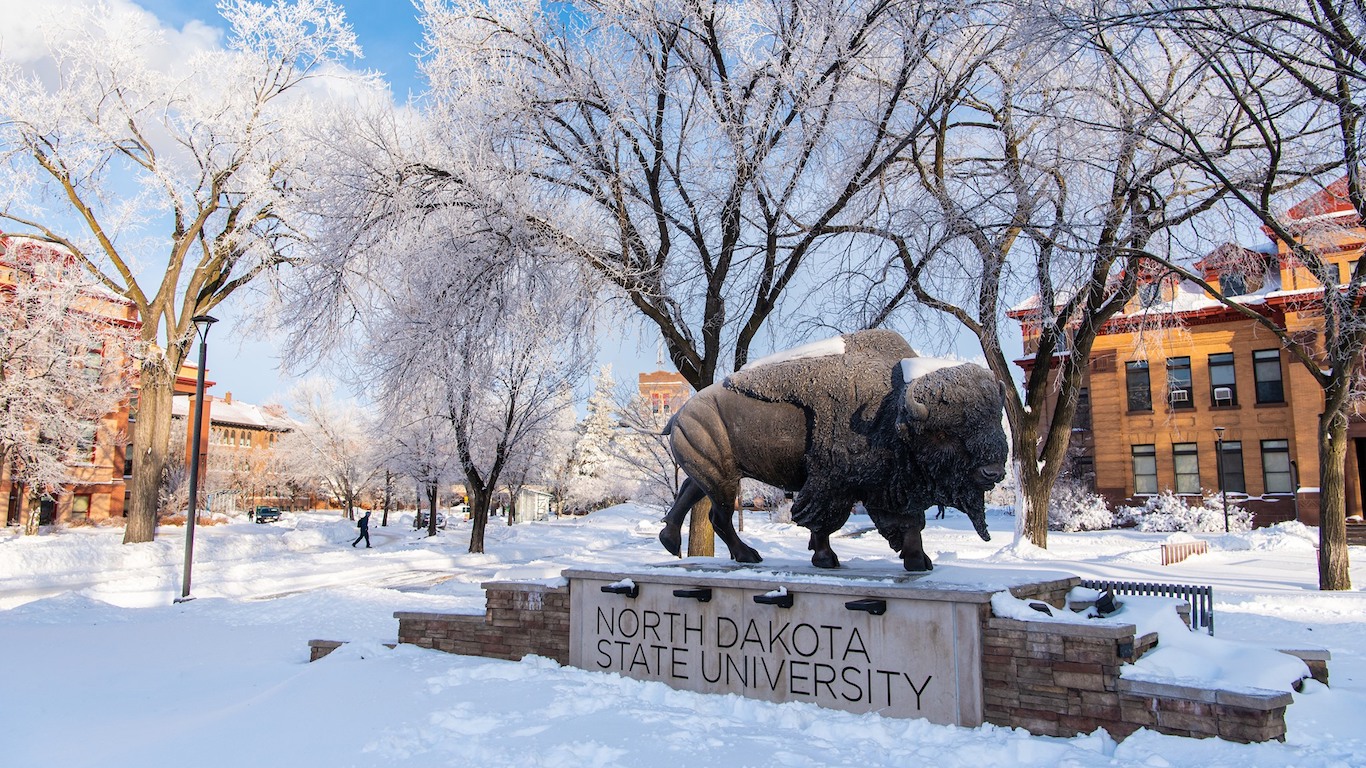
25. North Dakota State University-Main Campus
> Located in: Fargo, ND
> Chance two random students are a different race, ethnicity, or citizenship: 25.2%
> Largest racial/ethnic group: White (87.7% of U.S. students)
> Undergraduate enrollment: 11,425
> Avg. cost of attendance: $19,874
North Dakota State University is a large public school based in Fargo. The university is one of the least diverse colleges or universities in the country, with a nearly 90% white student body. The odds that two students chosen at random are of a different race, ethnicity, or U.S. citizenship status are only about one in four.
The state of North Dakota’s racial composition may largely explain the school’s relative lack of diversity. The cost of attendance for students from the state attending NDSU is roughly two-thirds of what students from other states pay — and 85% of North Dakota residents identify as white. The school appears to be striving for greater diversity, however, offering qualifying racial and ethnic groups a tuition waiver.
[in-text-ad]
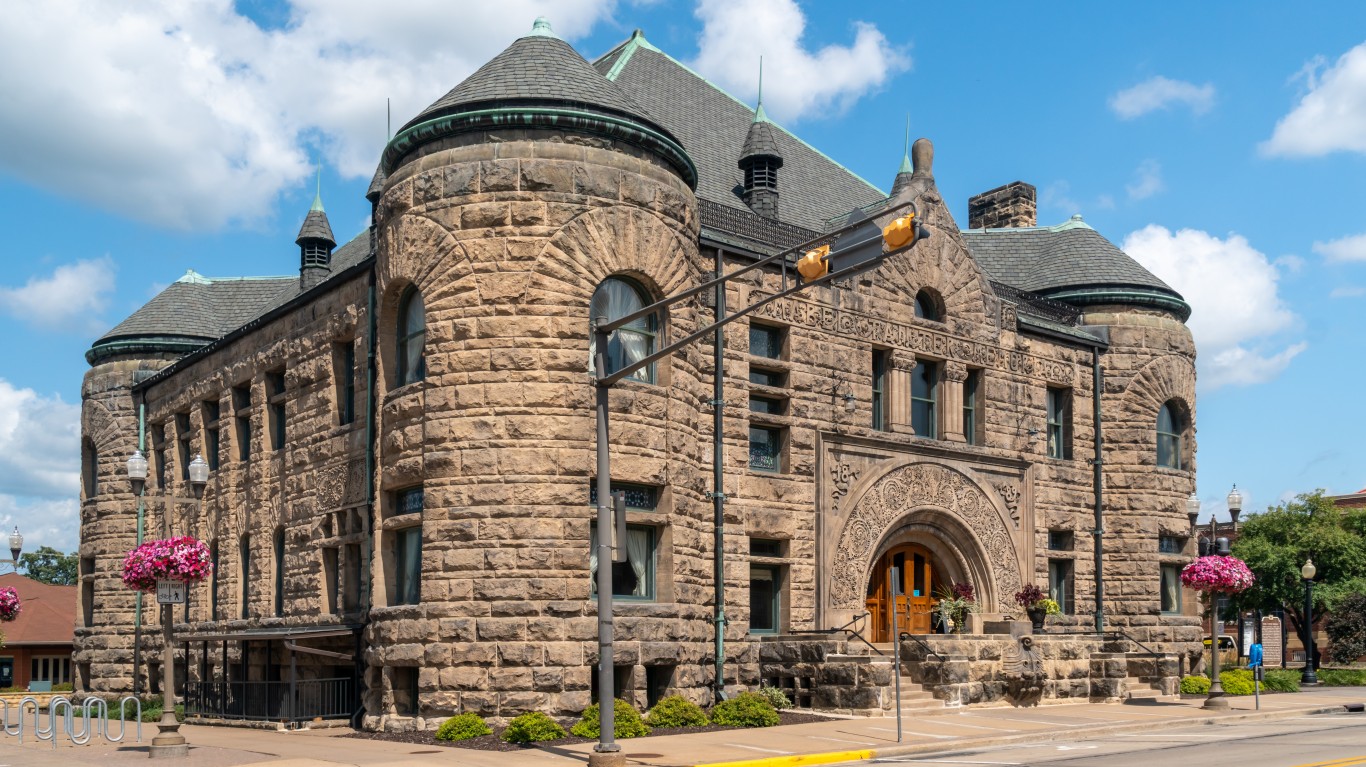
24. University of Wisconsin-Stout
> Located in: Menomonie, WI
> Chance two random students are a different race, ethnicity, or citizenship: 25.0%
> Largest racial/ethnic group: White (88.1% of U.S. students)
> Undergraduate enrollment: 7,577
> Avg. cost of attendance: $19,233
University of Wisconsin-Stout is one of several predominantly white schools in the Midwest to rank on this list. Among undergraduate student survey respondents who are U.S. citizens, 88.1% identified as white, well above the comparable national share of 50.8% of American undergraduates. The school’s lack of diversity is likely closely tied to the demographics of Wisconsin as a whole. More than 80% of the state population identifies as white, well above the 61.1% share of Americans. And like other public schools on this list, UW-Stout offers a generous discount to in-state residents. Wisconsin residents pay about 33% less in tuition and fees than students from outside the state.
UW-Stout offers a Multicultural Student Scholarship for qualifying minority groups, at $2,500 a year — about 15% of the the total cost for in state students and 10% of the cost for students not from Wisconsin.
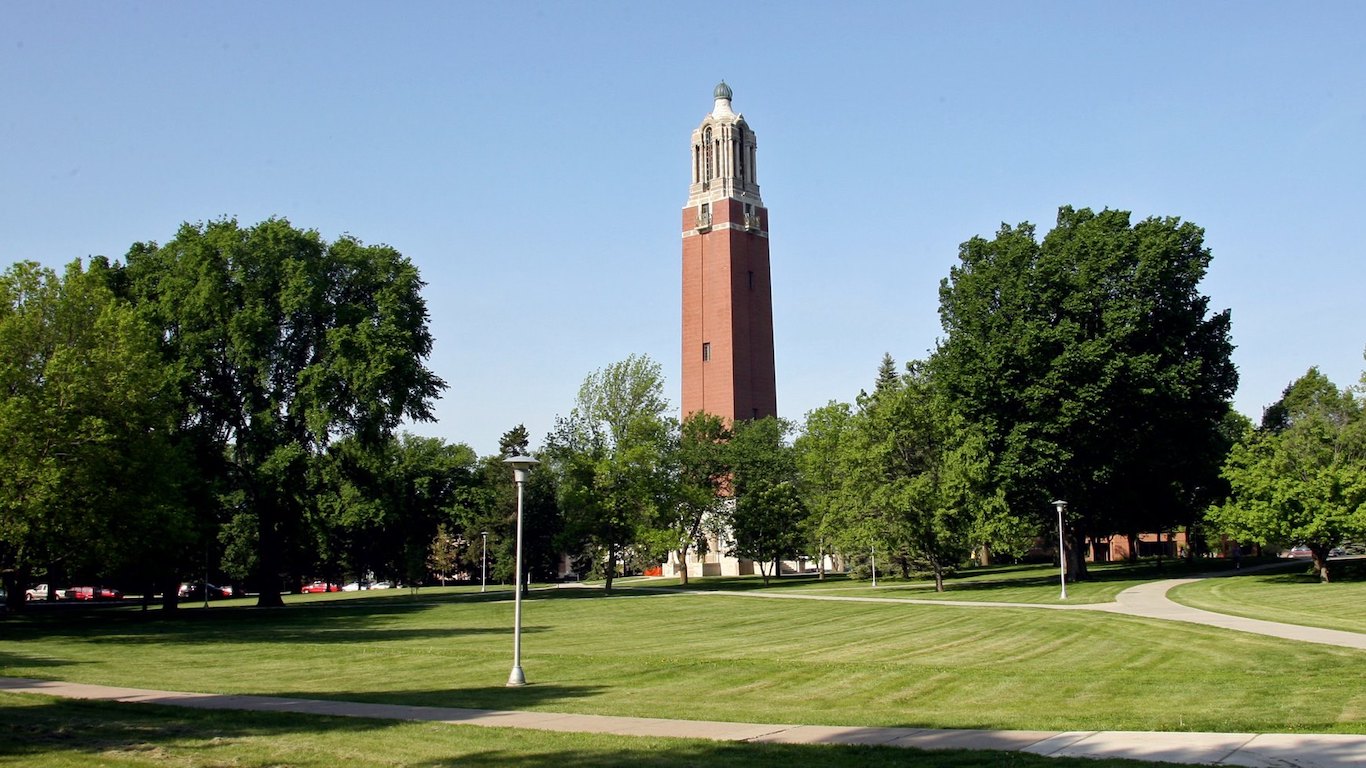
23. South Dakota State University
> Located in: Brookings, SD
> Chance two random students are a different race, ethnicity, or citizenship: 25.0%
> Largest racial/ethnic group: White (89.9% of U.S. students)
> Undergraduate enrollment: 10,544
> Avg. cost of attendance: $22,410
South Dakota State University is one of several public schools in the Midwest to rank on this list. Nearly 90% of the undergraduate student body who are U.S. citizens identify as white, and the probability that two students chosen at random would be of a different race, ethnicity, or citizenship status is just 25%. Among all U.S. undergraduates, the likelihood is nearly 70%.
Like many of the least diverse schools in the country, South Dakota State is not especially selective. In the 2018-2019 school year, SD State sent offer letters to 92.4% of those who applied.
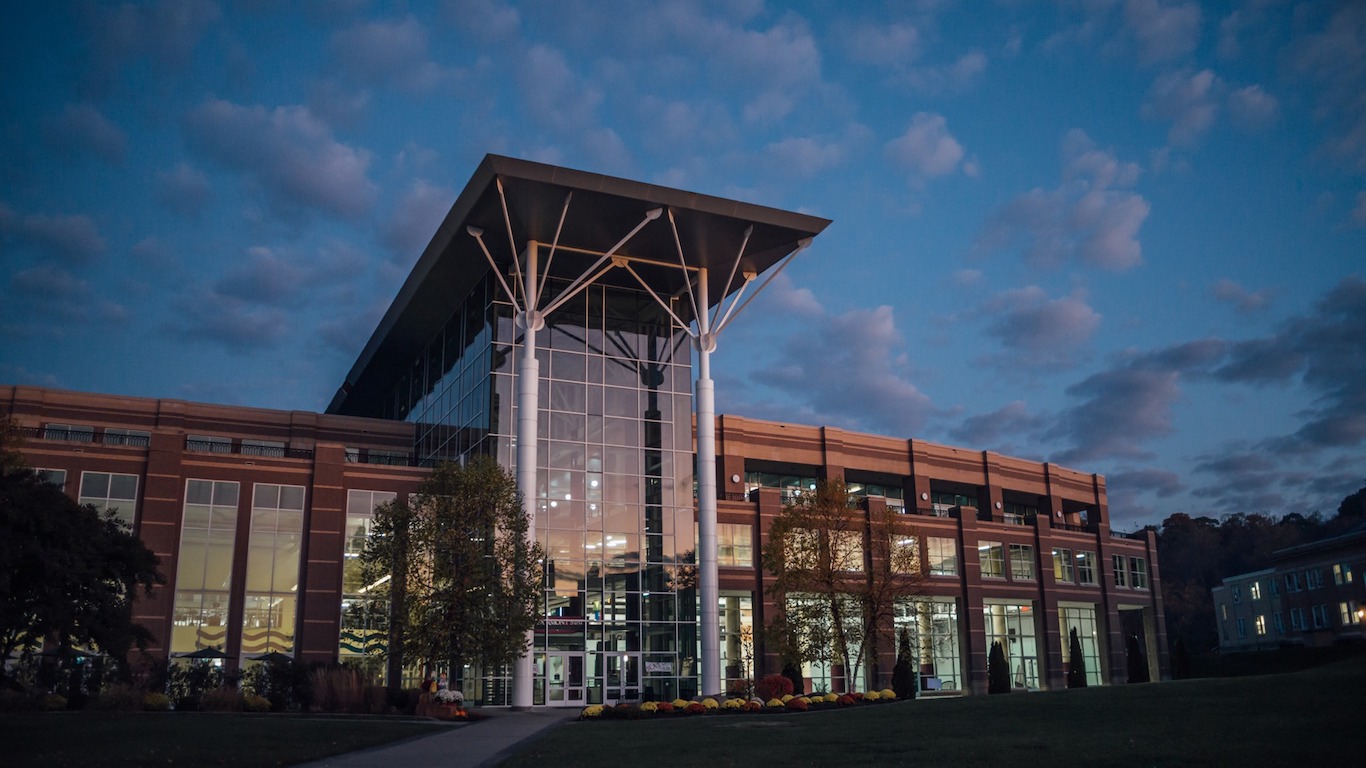
22. Fairmont State University
> Located in: Fairmont, WV
> Chance two random students are a different race, ethnicity, or citizenship: 24.4%
> Largest racial/ethnic group: White (88.7% of U.S. students)
> Undergraduate enrollment: 3,674
> Avg. cost of attendance: $16,375
Fairmont State, a public university in West Virginia, is one of only 22 four-year colleges and universities nationwide where the likelihood that two students chosen at random would be of a different race, ethnicity, or citizenship status is less than 25%. In-state tuition is less than half the tuition for students from out of state, which makes students at the school far more likely to be from West Virginia than anywhere else — and 92.1% of West Virginia’s population identifies as white.
Though it ranks as one of the least diverse four-year schools in the country, Fairmont State is more diverse than West Virginia as a whole. Across the state, the odds that two residents would be of a different race or ethnicity are just 15.0%.
[in-text-ad-2]
21. Cedarville University
> Located in: Cedarville, OH
> Chance two random students are a different race, ethnicity, or citizenship: 23.9%
> Largest racial/ethnic group: White (88.6% of U.S. students)
> Undergraduate enrollment: 3,749
> Avg. cost of attendance: $37,623
Cedarville University is a private school in Cedarville, Ohio. About 89% of U.S. citizens enrolled in the school identify as white, making it one of the least diverse four-year colleges and universities in the country. Though the student body is not especially diverse, the school expresses its commitment to making the campus a place for people of all backgrounds, stating on its website: “we recognize that the issue of diversity is challenging, and we are working hard to create a campus atmosphere where minority students feel welcome.”
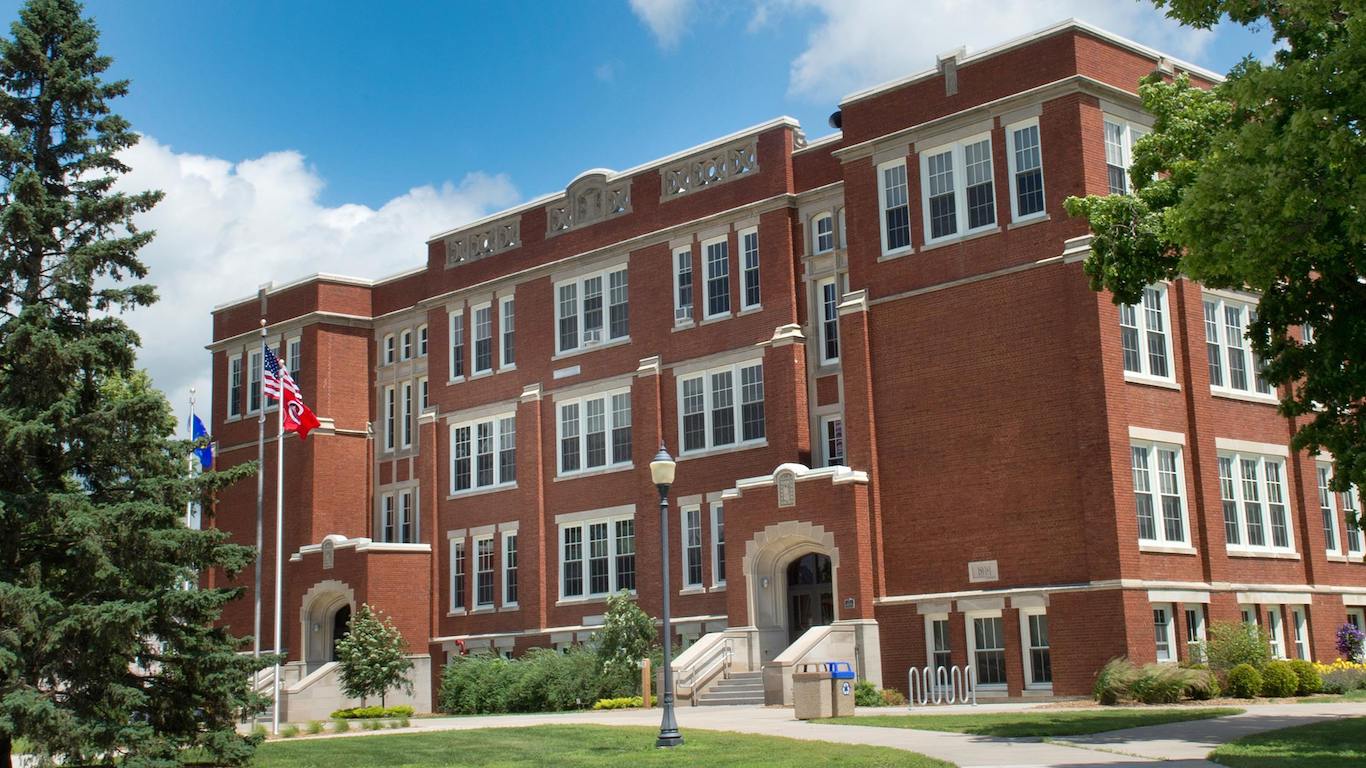
20. University of Wisconsin-River Falls
> Located in: River Falls, WI
> Chance two random students are a different race, ethnicity, or citizenship: 23.4%
> Largest racial/ethnic group: White (88.8% of U.S. students)
> Undergraduate enrollment: 5,726
> Avg. cost of attendance: $18,201
University of Wisconsin-River Falls is a four-year public university. About 89% of American undergraduate students enrolled in the school identify as white alone, and the odds that two students chosen at random would be of a different race, ethnicity, or U.S. citizenship status are only 23.4%, well below the national figure of 69.6%.
While the on-campus educational experience at UWRF may not be especially diverse, some enrolled students still have the opportunity to be immersed in different cultures. Each year, over 350 students at the school choose to study abroad, enrolling in programs in countries all over the word, including China, Greece, Italy, Mexico, Poland, South Africa, and Spain.
[in-text-ad]

19. University of Wisconsin-Eau Claire
> Located in: Eau Claire, WI
> Chance two random students are a different race, ethnicity, or citizenship: 23.3%
> Largest racial/ethnic group: White (89.3% of U.S. students)
> Undergraduate enrollment: 10,888
> Avg. cost of attendance: $19,591
University of Wisconsin-Eau Claire is one of five schools in the University of Wisconsin system to rank on this list. Wisconsin’s population is much whiter than the nation as a whole — 81.5% versus 61.1%.
The University of Wisconsin-Eau Claire appears to be taking steps to becoming a more attractive place for students from diverse backgrounds. In 2017, the school established a vice chancellor to implement its plan of equity, diversity, and inclusion, which aims at creating an open campus free of racism, sexism, homophobia, and xenophobia.

18. Central Methodist University-College of Graduate and Extended Studies
> Located in: Fayette, MO
> Chance two random students are a different race, ethnicity, or citizenship: 23.3%
> Largest racial/ethnic group: White (87.6% of U.S. students)
> Undergraduate enrollment: 3,558
> Avg. cost of attendance: N/A
Central Methodist University-College of Graduate and Extended Studies, which is affiliated with the United Methodist church, is a private school. Though it is based in Fayette, Missouri, the school also offers classes online as well as at several sites across the state.
About 88% of CMU CGES students who are U.S. citizens identify as white. Due largely to its considerable white student body, the likelihood that two students chosen at random would be of a different racial, ethnic, or U.S. citizenship status is just 23.3%.
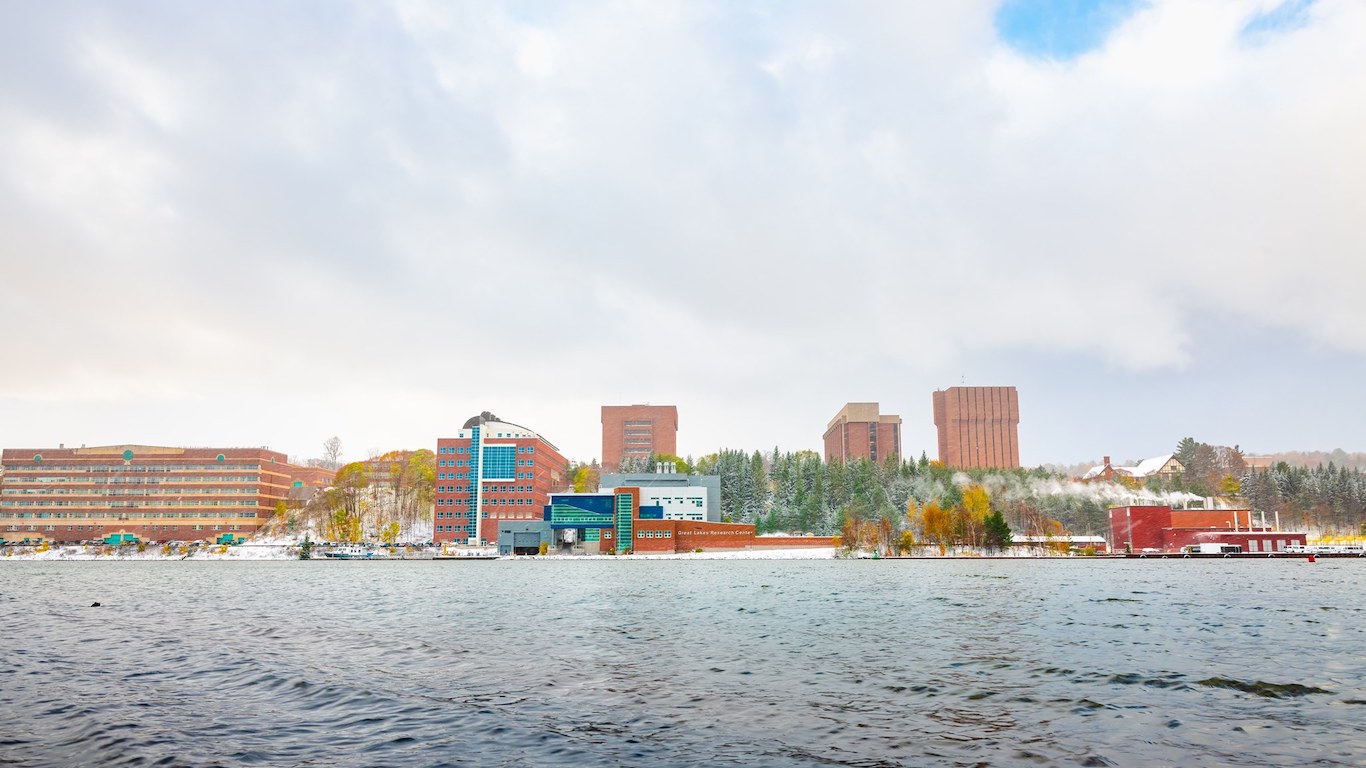
17. Michigan Technological University
> Located in: Houghton, MI
> Chance two random students are a different race, ethnicity, or citizenship: 22.4%
> Largest racial/ethnic group: White (89.7% of U.S. students)
> Undergraduate enrollment: 5,797
> Avg. cost of attendance: $27,537
There is a just a 22.4% chance that two randomly chosen students would have a different racial orethnic background, or a different U.S. citizenship status, at Michigan Technological University. About nine out of every 10 American undergraduate students on campus identify as white, a far larger than typical share.
Though the school itself, which started out as a mining school in 1885, does not have an especially diverse student body, it does celebrate diversity. Every September, the school hosts a Parade of Nations event — the oldest and largest multicultural event in the region — to celebrate the 50 countries represented by those living in the broader community.
[in-text-ad-2]

16. University of Wisconsin-Platteville
> Located in: Platteville, WI
> Chance two random students are a different race, ethnicity, or citizenship: 22.2%
> Largest racial/ethnic group: White (89.5% of U.S. students)
> Undergraduate enrollment: 8,123
> Avg. cost of attendance: $18,494
Like the other University of Wisconsin schools on this list, UW Platteville has a predominantly white student body — with about 90% of undergraduates who are American citizens identifying as white. Partially as a result, there is a just a 22.2% probability that two randomly chosen students would have a different racial or ethnic background.
Wisconsin’s population is far whiter than the nation as a whole — 81.5% versus 61.1% — and as a state school, UW Platteville offers steep discounts to students from the state. Annual tuition and fees for in-state students is just under $8,000. Meanwhile, American students from most other states pay nearly $16,000, and international students pay over $17,000.

15. Howard University
> Located in: Washington, DC
> Chance two random students are a different race, ethnicity, or citizenship: 21.4%
> Largest racial/ethnic group: Black or African American (94.1% of U.S. students)
> Undergraduate enrollment: 6,243
> Avg. cost of attendance: $41,488
Washington D.C.-based Howard University is one of several historically black colleges and universities to rank on this list. Founded in 1867, the school has produced many prominent black professionals across multiple fields, including the first African American to serve on the U.S. Supreme Court. It is also committed “to the study of disadvantaged persons in American society and throughout the world.”
Over 94% of American undergraduates at Howard University identify as black. Additionally, the odds that two students chosen at random would have a different ethnic or racial background or differ in U.S. citizenship status are only 21.4%.
[in-text-ad]
14. Morehead State University
> Located in: Morehead, KY
> Chance two random students are a different race, ethnicity, or citizenship: 21.3%
> Largest racial/ethnic group: White (89.9% of U.S. students)
> Undergraduate enrollment: 9,395
> Avg. cost of attendance: $20,507
Morehead State University is a public school located in Rowan County, Kentucky. About nine in every 10 American students at the school identify as white. With such a large white population, there is just a 21.3% chance that two Morehead State students chosen at random would be of two different racial, ethnic, or national backgrounds, a much lower chance than in the vast majority of higher education institutions in the United States.
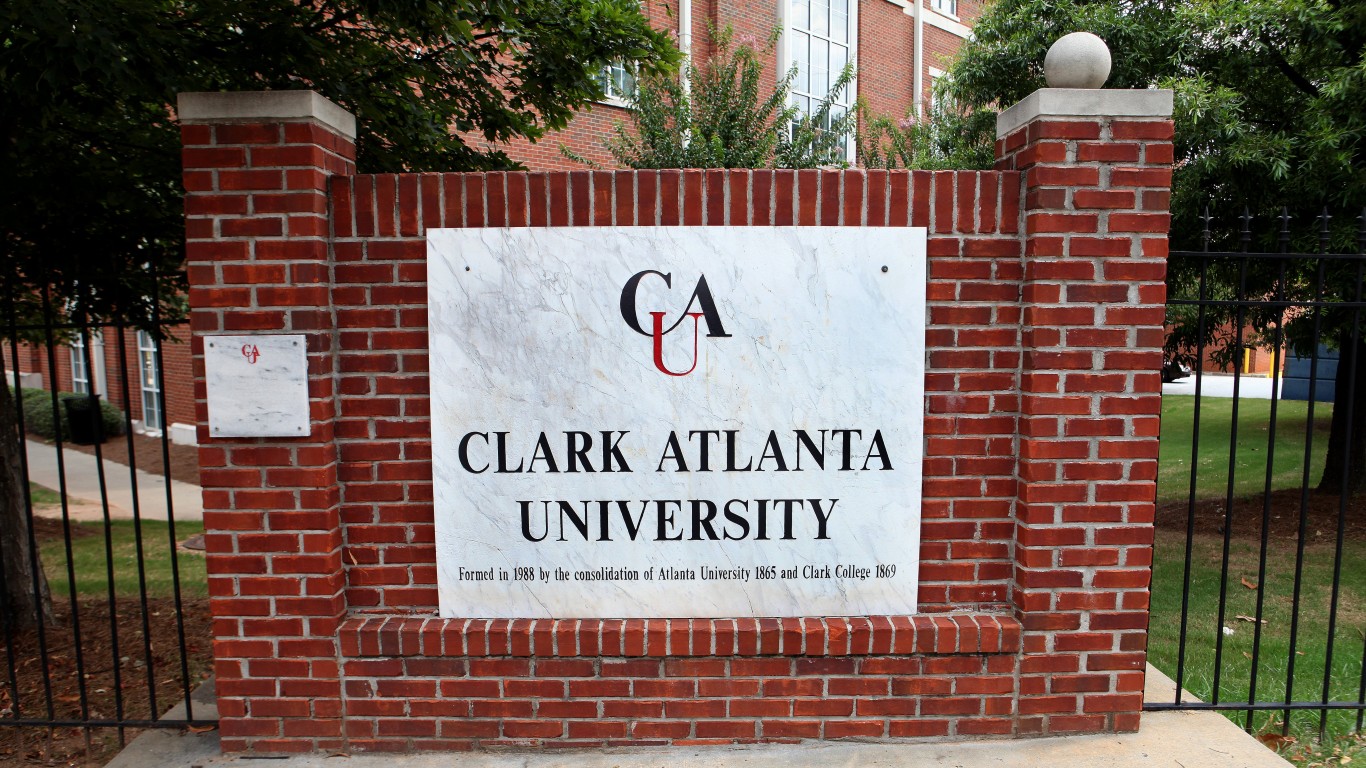
13. Clark Atlanta University
> Located in: Atlanta, GA
> Chance two random students are a different race, ethnicity, or citizenship: 21.0%
> Largest racial/ethnic group: Black or African American (92.3% of U.S. students)
> Undergraduate enrollment: 3,325
> Avg. cost of attendance: $37,761
Founded in 1988, Clark Atlanta University is a relatively new school. The school has a predominantly black student body. It was formed when Atlanta University, the first institution to grant degrees to African Americans, and Clark College, the first mostly black four-year liberal arts school in the United States, merged into a single entity. It is one of several historically black colleges and universities to rank on this list.
The likelihood that two students chosen at random would be of a different racial or ethnic background, or a different U.S. citizenship status, is just 21%.

12. University of Wisconsin-La Crosse
> Located in: La Crosse, WI
> Chance two random students are a different race, ethnicity, or citizenship: 19.9%
> Largest racial/ethnic group: White (90.3% of U.S. students)
> Undergraduate enrollment: 9,727
> Avg. cost of attendance: $17,235
Of the five University of Wisconsin schools on this list, UW La Crosse is the least diverse. About nine in every 10 American undergraduate students at the school identify as white. There is only a 19.9% chance that two students chosen at random would identify as a different race or ethnicity, or differ in U.S. citizenship status.
Though the school is not especially diverse, UW La Crosse’s stated long-term vision includes encouraging a more multicultural student body. The school has an explicit goal “to commit human and financial resources that support an inclusive campus that attracts and retains diverse students, faculty and staff.”
[in-text-ad-2]

11. Grambling State University
> Located in: Grambling, LA
> Chance two random students are a different race, ethnicity, or citizenship: 18.5%
> Largest racial/ethnic group: Black or African American (94.5% of U.S. students)
> Undergraduate enrollment: 4,110
> Avg. cost of attendance: $25,358
Grambling State University is one of two historically black schools in Louisiana to rank on this list. Founded in 1901, the school was originally called the Colored Industrial and Agricultural School and was later renamed the Louisiana Negro Normal and Industrial Institute before changing its name to Grambling in 1946.
Today, nearly 95% of American students at the school identify as black. The chances that two students chosen at random fall into a different category of race, ethnicity, or U.S. citizenship are only 18.5%.

10. The University of Texas Rio Grande Valley
> Located in: Edinburg, TX
> Chance two random students are a different race, ethnicity, or citizenship: 18.4%
> Largest racial/ethnic group: Hispanic (92.4% of U.S. students)
> Undergraduate enrollment: 24,678
> Avg. cost of attendance: $13,401
The University of Texas Rio Grande Valley is one of only two schools on this list where the majority of American citizen undergraduate students identify as Hispanic. Located in Edinburg, Texas, the school is less than 30 miles from the U.S.-Mexico border. By far the newest school on this list, UTRGV was created in 2013 by the Texas legislature.
More than 90% of students who are U.S. citizens are Hispanic.
[in-text-ad]
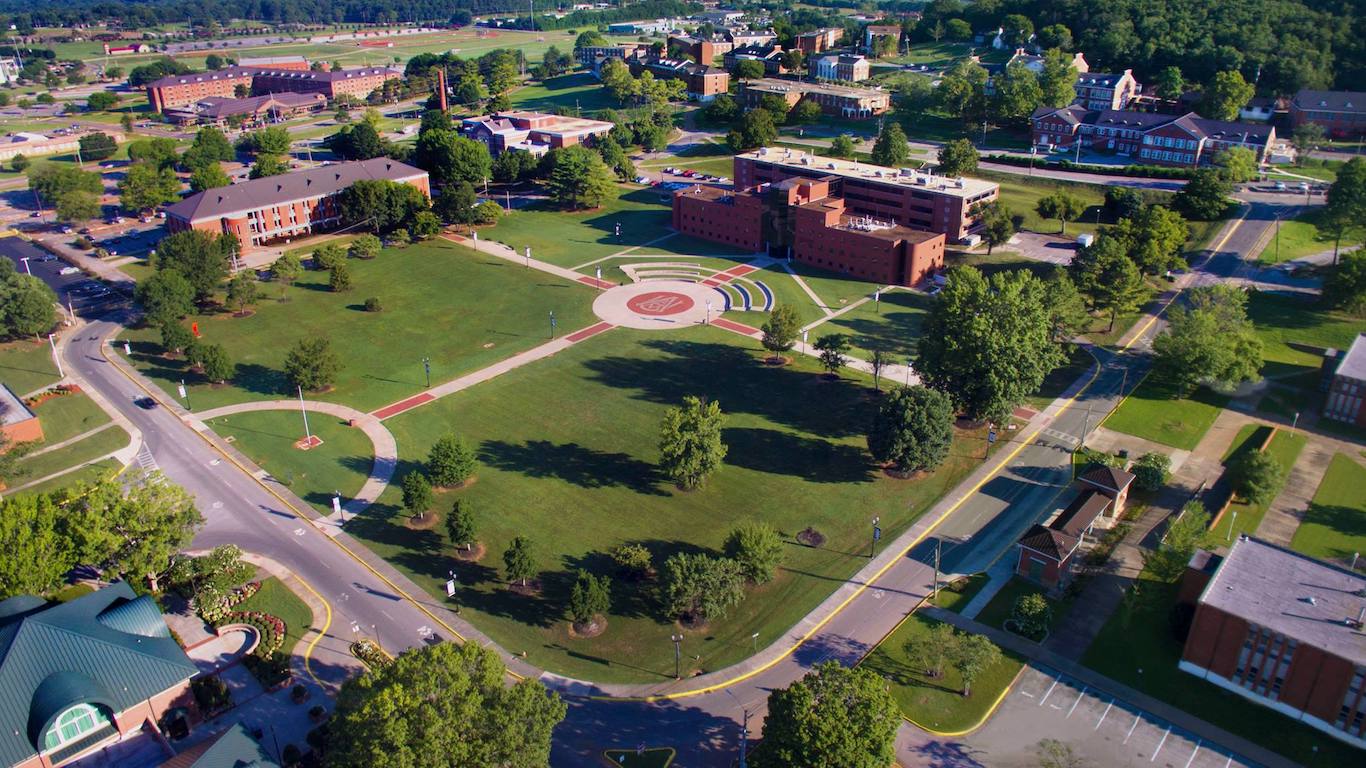
9. Alabama A&M University
> Located in: Normal, AL
> Chance two random students are a different race, ethnicity, or citizenship: 17.0%
> Largest racial/ethnic group: Black or African American (91.7% of U.S. students)
> Undergraduate enrollment: 5,143
> Avg. cost of attendance: $22,886
Alabama A&M University is one of several historically black colleges and universities on this list. Among undergraduates who are U.S. citizens, 91.7% identify as black, well above the comparable national share of 12.7% among American undergraduates.
Alabama has one of the largest black populations of any state as more than one in every four residents identify as black. In addition to the school’s status as a historically black institution, also explaining the large black population at Alabama A&M is that in-state residents pay about half as much in tuition as those from out of state.
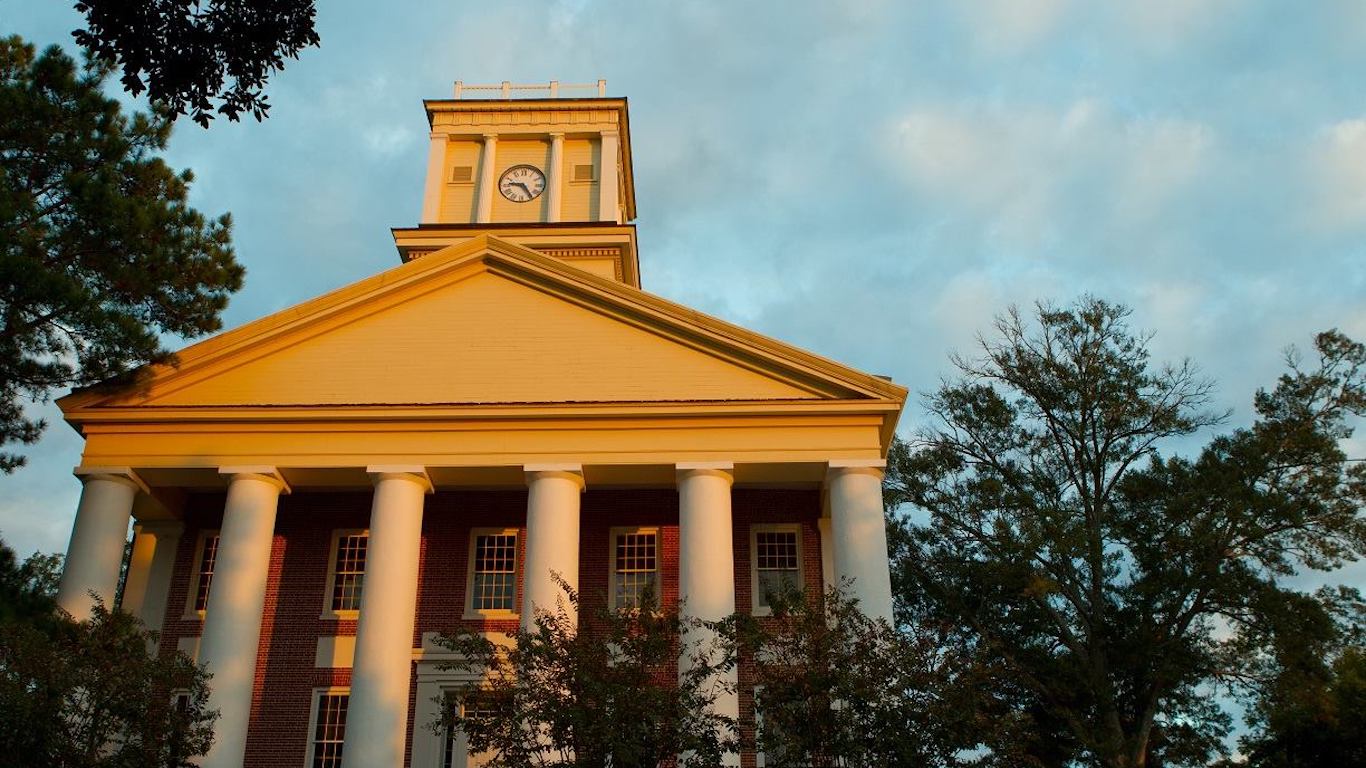
8. Alcorn State University
> Located in: Alcorn State, MS
> Chance two random students are a different race, ethnicity, or citizenship: 16.6%
> Largest racial/ethnic group: Black or African American (95.8% of U.S. students)
> Undergraduate enrollment: 3,173
> Avg. cost of attendance: $22,357
Founded in 1871, Alcorn State University is the oldest public, historically black land grant university in the United States and the second oldest state-supported higher education institution in Mississippi. Today, 95.8% of American students enrolled at Alcorn State identify as black.
Despite being one of the least racially or ethnically diverse schools in the country, Alcorn State recognizes the importance of a diverse student body. The school maintains that “diversity of thought, identity, and life experience offer tremendous resources, and the spirit of multiculturalism must be infused throughout our institution to ensure the richest possible living, learning, and working environment.”

7. Jackson State University
> Located in: Jackson, MS
> Chance two random students are a different race, ethnicity, or citizenship: 15.7%
> Largest racial/ethnic group: Black or African American (93.5% of U.S. students)
> Undergraduate enrollment: 5,331
> Avg. cost of attendance: $22,397
What is now known as Jackson State University was founded in 1877. A historically black university, Jackson State’s undergraduate student body with U.S. citizenship is 93.5% black.
Jackson State is located in Jackson, Mississippi’s state capital. Jackson has one of the largest concentrations of black residents of any U.S. city. Of the nearly quarter million people who live in Hinds County, which covers parts of Jackson and Jackson State University, about 72% identify as black, well above the 12.3% share of Americans nationwide.
[in-text-ad-2]
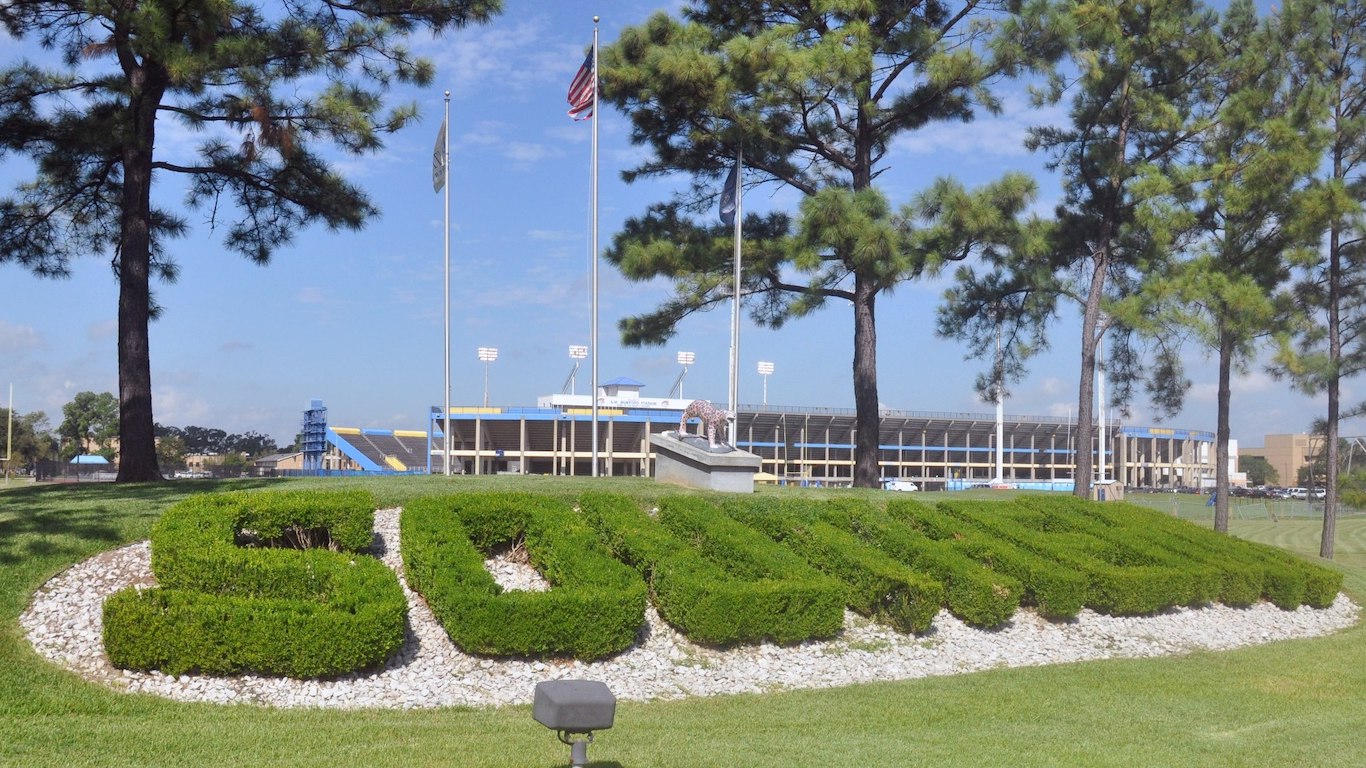
6. Southern University and A&M College
> Located in: Baton Rouge, LA
> Chance two random students are a different race, ethnicity, or citizenship: 14.6%
> Largest racial/ethnic group: Black or African American (93.0% of U.S. students)
> Undergraduate enrollment: 5,838
> Avg. cost of attendance: $20,689
Southern University and A&M College is the least diverse primarily bachelor’s degree-granting college or university with at least 2,500 undergraduates in Louisiana and the fifth least diverse in the United States. The odds that two random undergraduate students at the historically black university fall into a different racial or ethnic category, or differ in U.S. citizenship status, are just 14.6%. The odds that two random undergraduate students nationwide are of different backgrounds are 69.6%.
Of undergraduates enrolled at Southern University and A&M College, roughly 93% identify as black.

5. Yeshiva University
> Located in: New York, NY
> Chance two random students are a different race, ethnicity, or citizenship: 12.9%
> Largest racial/ethnic group: White (98.6% of U.S. students)
> Undergraduate enrollment: 2,728
> Avg. cost of attendance: $58,845
Yeshiva University is a New York City-based school that describes itself as a Jewish institution for higher education. Nearly 99% of undergraduate students who are U.S. citizens identify as white, well above the comparable 50.8% share of American undergraduates nationwide. Due largely to its considerable white student body, the likelihood that two students chosen at random would be of a different nationality or racial or ethnic background, or differ in U.S. citizenship status, is just 12.9%.
[in-text-ad]

4. Alabama State University
> Located in: Montgomery, AL
> Chance two random students are a different race, ethnicity, or citizenship: 12.5%
> Largest racial/ethnic group: Black or African American (94.5% of U.S. students)
> Undergraduate enrollment: 3,903
> Avg. cost of attendance: $19,413
Alabama State University is one of several public, historically black southern schools to rank on this list. The probability that two students chosen at random would be of a different nationality or racial or ethnic background is just 12.9%. Based on that metric, it is the least diverse school with at least 2,500 undergraduates in Alabama and fourth least diverse in the United States.
The school traces its roots back to 1867 in the wake of the Civil War. At the time, black Southerners had recently gained the right to an education, and through the combined effort of white missionaries from Northern states and African American church leaders, educational institutions were formed for freedmen, including what would later become Alabama State University.
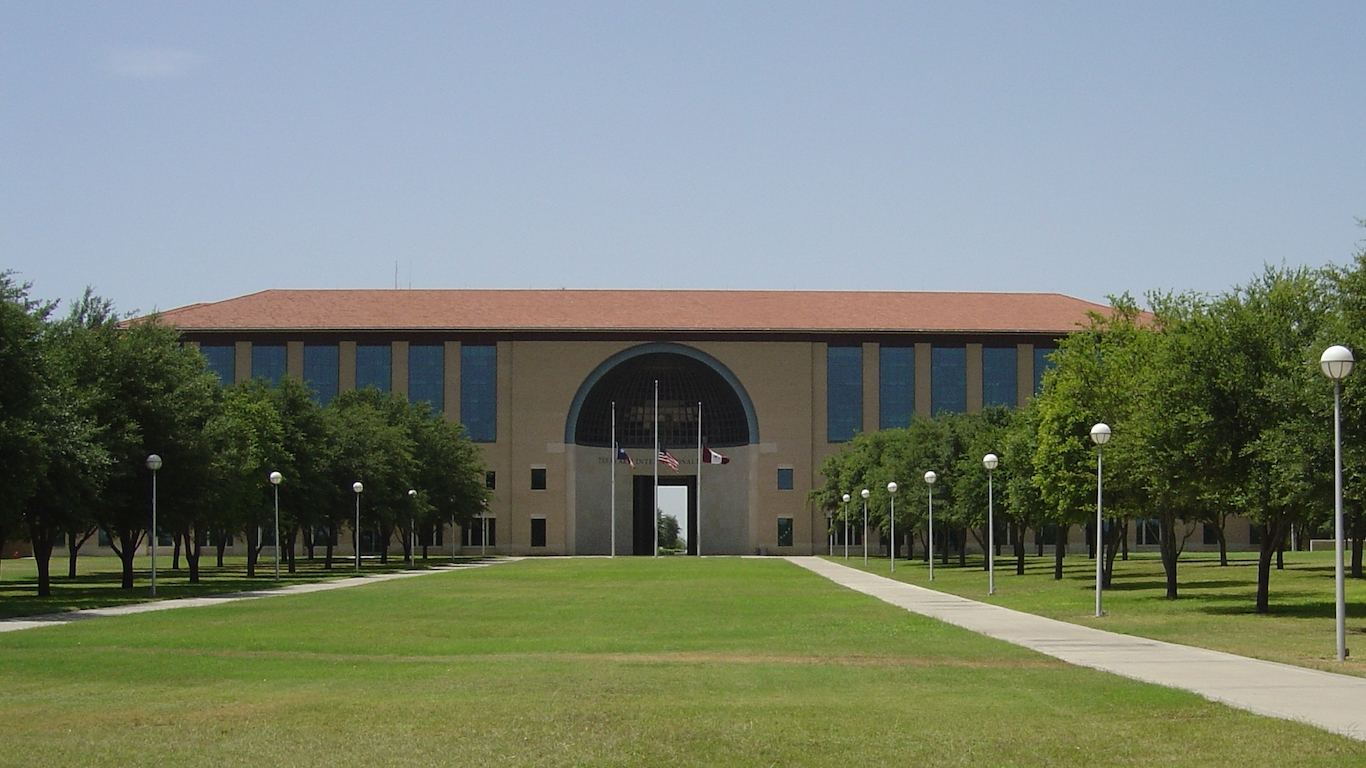
3. Texas A & M International University
> Located in: Laredo, TX
> Chance two random students are a different race, ethnicity, or citizenship: 10.0%
> Largest racial/ethnic group: Hispanic (96.4% of U.S. students)
> Undergraduate enrollment: 6,992
> Avg. cost of attendance: $13,629
Texas A&M International University is located in Laredo, Texas, a city that sits along the U.S.-Mexico border. It is one of two Texas schools on this list with a predominantly Hispanic undergraduate population. Of the U.S. citizens enrolled in an undergraduate program with the school, 96.4% identify as Hispanic, well above the comparable 21.0% share among undergraduates nationwide.
The school traces its roots back to 1970, and it became known as Texas A&M International University in 1993. Due in large part to its geographic location, the school describes itself as “the cultural and intellectual hub of a vibrant multilingual and multicultural community.”
2. Hampton University
> Located in: Hampton, VA
> Chance two random students are a different race, ethnicity, or citizenship: 8.0%
> Largest racial/ethnic group: Black or African American (96.7% of U.S. students)
> Undergraduate enrollment: 3,672
> Avg. cost of attendance: $38,849
Hampton University is a small, private liberal arts school located in Hampton, Virginia. With over 95% of undergraduates with U.S. citizenship identifying as black, Hampton University is one of the least diverse schools in the country. A historically black school, Hampton University traces its roots back to the Civil War when it was an area in which escaped slaves were educated. The school’s notable alumni include several African American lawmakers and politicians, as well as Booker T. Washington, founder of what is now Tuskegee University.
[in-text-ad-2]
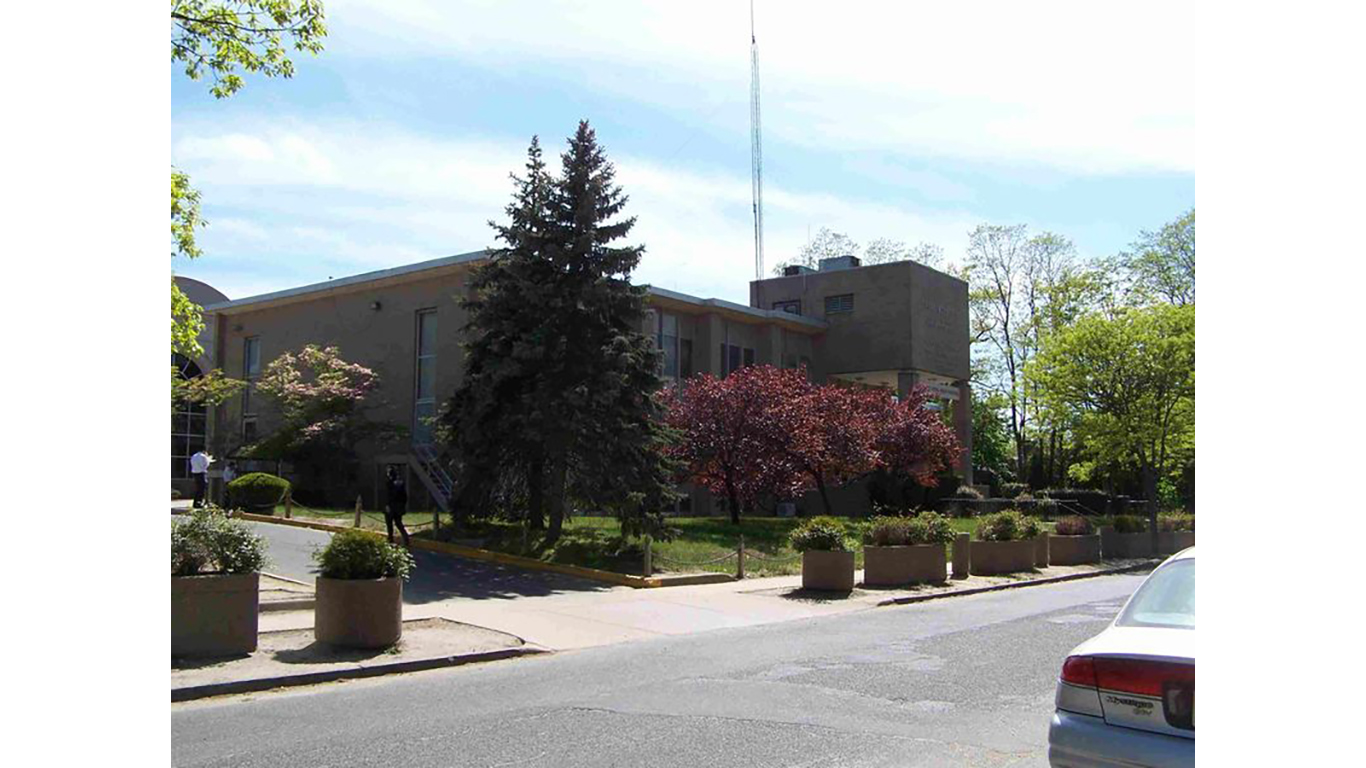
1. Beth Medrash Govoha
> Located in: Lakewood, NJ
> Chance two random students are a different race, ethnicity, or citizenship: 6.1%
> Largest racial/ethnic group: White (99.9% of U.S. students)
> Undergraduate enrollment: 2,680
> Avg. cost of attendance: N/A
Beth Medrash Govoha ranks as the least diverse primarily bachelor’s school in the United States. The odds that two students chosen at random would have a different ethnic or racial background or differ in U.S. citizenship status are only 6.1%. This is due primarily to the school’s predominantly white student body. Some 99.9% of students at the school who are U.S. citizens identify as white. One of several schools on this list with a religious affiliation, Beth Medrash Govah is an elite, all male school for Jewish religious study.
Detailed Findings
Explanations for the relative lack of diversity among the schools on this list vary. One common explanation is the demographic makeup of the surrounding region and state. Many of the schools on this list are public universities that offer steep tuition discounts to students who reside in the state. These schools are in predominantly white states, such as North Dakota, South Dakota, and Wisconsin. As such, their tuition structure likely contributes to racial homogeneity.
In other cases, the lack of diversity in the schools on this list is directly attributable to historical circumstances. Many of the least diverse schools in the country have majority black student bodies. These schools are located across the South and are known as historically black colleges and universities, or HBCUs. Schools like these were founded before the Civil Rights Act of 1964 with the express purpose of providing higher education to African Americans, who had little opportunity elsewhere.
Regardless of the reason the schools on this list lack diversity, a homogeneous student body can itself be self-perpetuating. According to Clark, many students want to be among other students that they can relate to.
“If you can see yourself in the faculty or in the other students, you’re more inclined to go to that institution,” Clark said. Prospective students who do not see others of the same race or ethnicity while on a tour of a given campus may be less likely to want to attend that school. “So it kind of feeds on itself too.”
Methodology
To determine the colleges and universities with the least diverse student bodies, 24/7 Wall St. ranked U.S. colleges and universities based on the likelihood that two undergraduate students picked at random would be of two different races, ethnicities, or U.S. citizenship status.
Data on racial and ethnic composition for U.S. colleges and universities came from the U.S. Department of Education’s Integrated Postsecondary Education Data System and is for the fall 2018 school semester. All race and ethnicity data is self reported. The categories included in the survey are: American Indian or Alaska Native; Asian; black or African American; Hispanic; Native Hawaiian or other Pacific Islander; white; two or more races; or nonresident alien.
Using this data, we calculated the index based on a diversity index originally developed in 1991 by Philip Meyer of the University of North Carolina and Shawn McIntosh of USA Today.
Supplemental data on average cost of attendance in the 2016-2017 school year, the admission rate in the 2018-2019 school year, and the size of the undergraduate population in fall 2018 also came from IPEDS.
We limited our universe to primarily bachelor’s degree granting institutions. Colleges at which more than 10% of undergraduate respondents chose not to identify as a specific race or ethnicity were excluded. Additionally, we only considered schools with at least 2,500.
Get Ready To Retire (Sponsored)
Start by taking a quick retirement quiz from SmartAsset that will match you with up to 3 financial advisors that serve your area and beyond in 5 minutes, or less.
Each advisor has been vetted by SmartAsset and is held to a fiduciary standard to act in your best interests.
Here’s how it works:
1. Answer SmartAsset advisor match quiz
2. Review your pre-screened matches at your leisure. Check out the advisors’ profiles.
3. Speak with advisors at no cost to you. Have an introductory call on the phone or introduction in person and choose whom to work with in the future
Thank you for reading! Have some feedback for us?
Contact the 24/7 Wall St. editorial team.
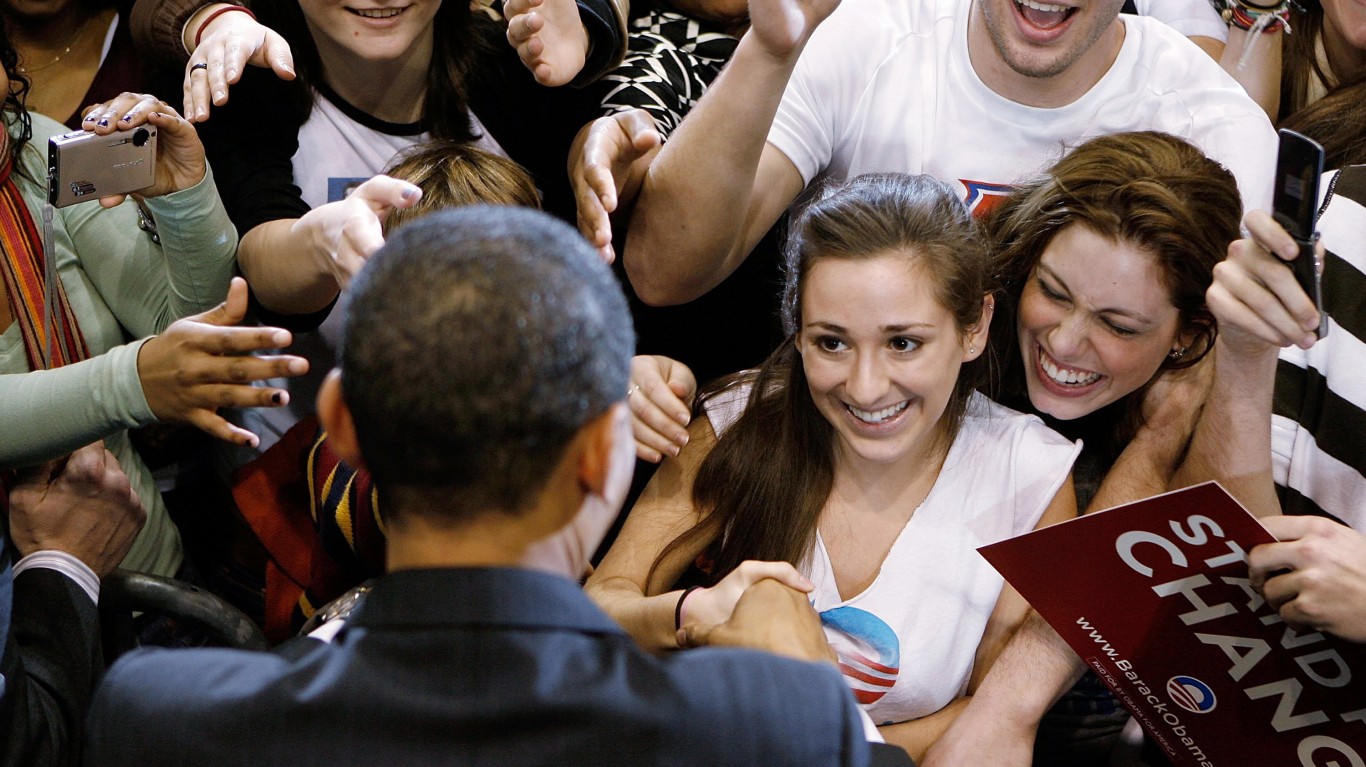 24/7 Wall St.
24/7 Wall St.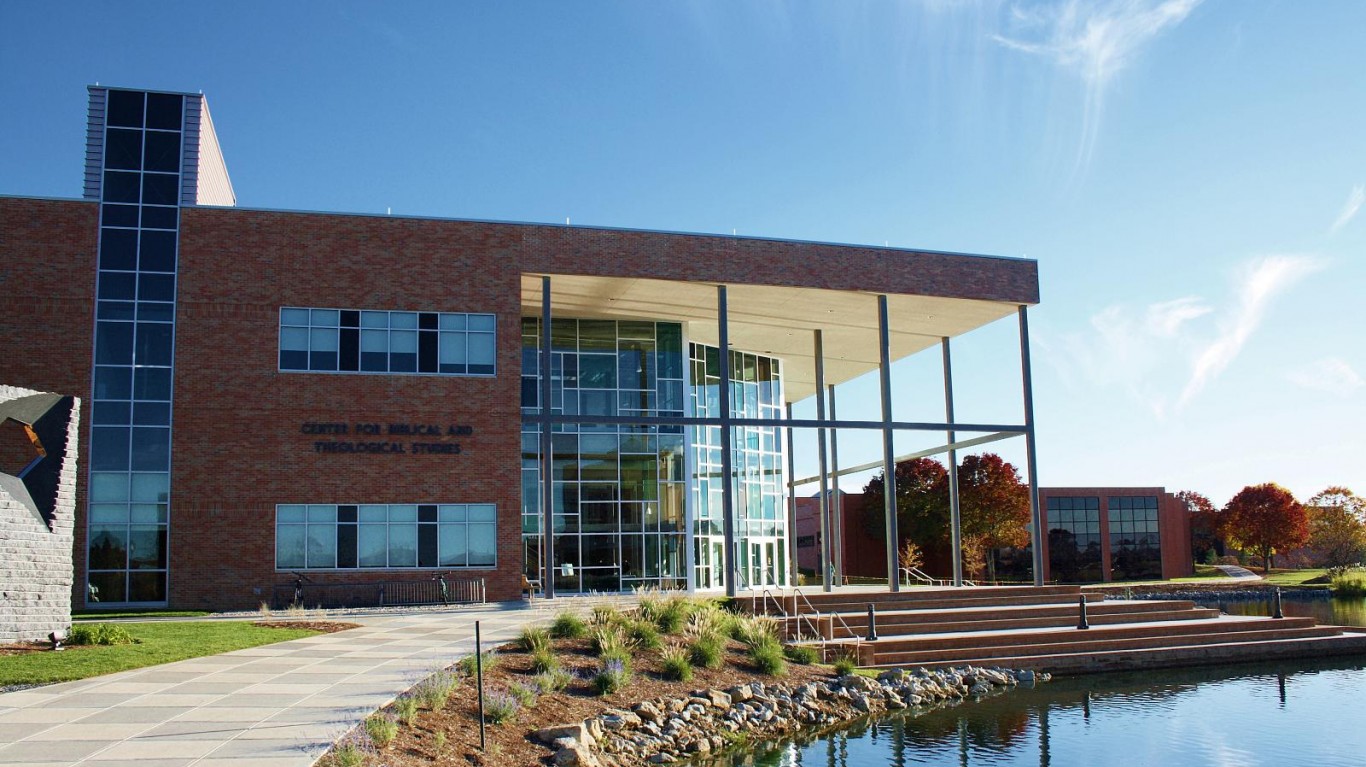
 24/7 Wall St.
24/7 Wall St.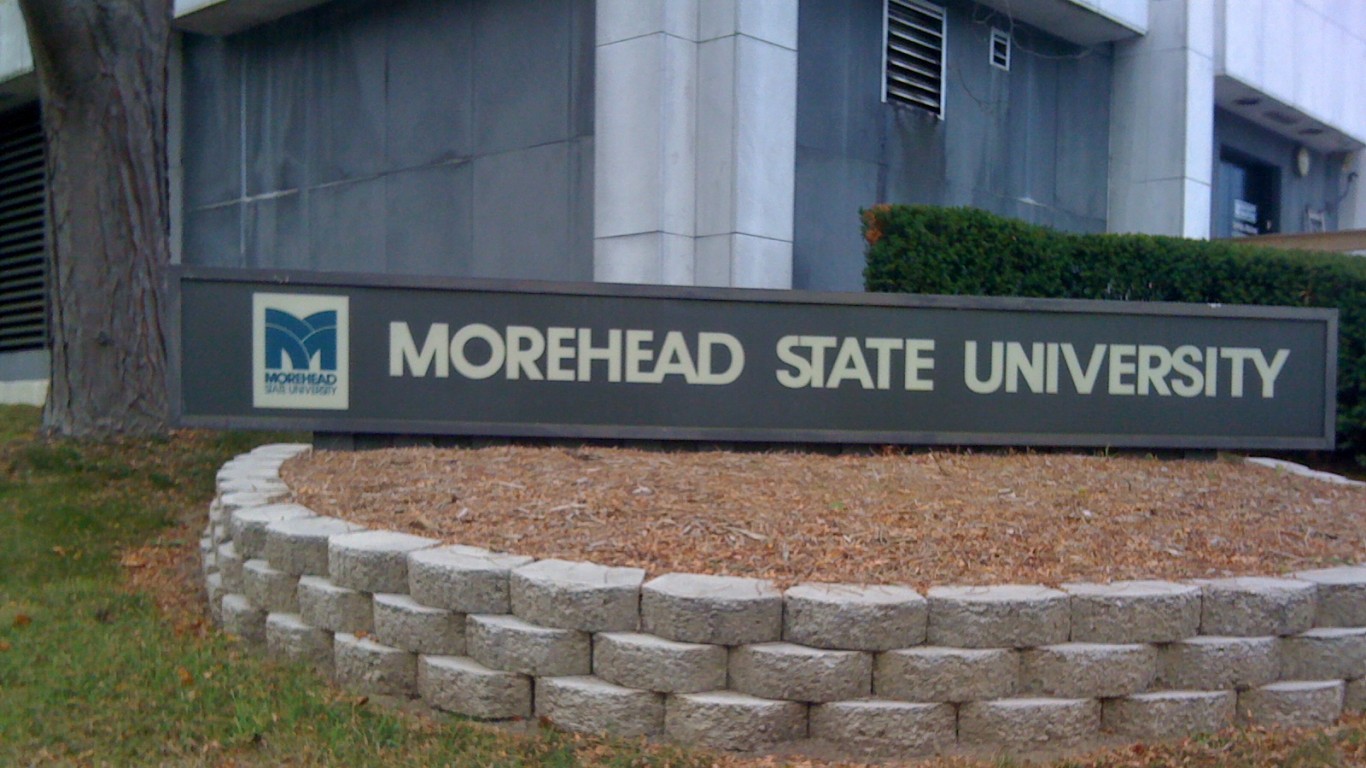
 24/7 Wall St.
24/7 Wall St. 24/7 Wall St.
24/7 Wall St. 24/7 Wall St.
24/7 Wall St.